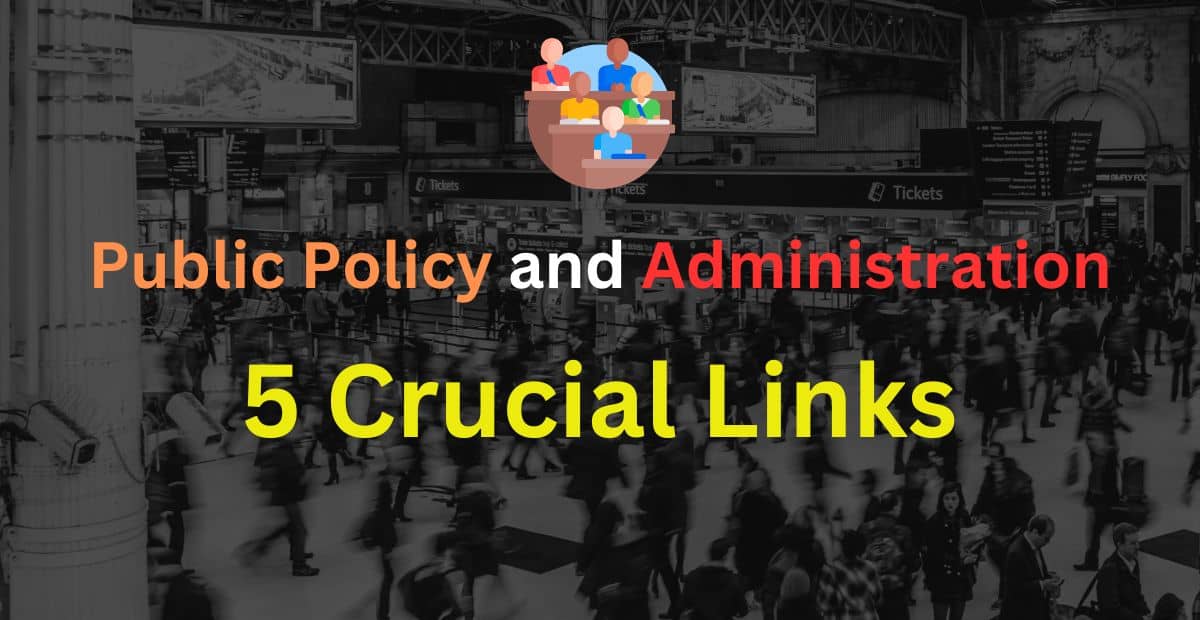Public policy and administration are closely interconnected fields that work in tandem to shape and implement policies within government structures. Here’s an overview of the relationship between public policy and administration:
Table of Contents
Public Policy
Public policy refers to the decisions, actions, and guidelines adopted by governments or public authorities to address societal issues and achieve specific goals. Public policies are formulated to address a wide range of concerns, such as social welfare, economic development, environmental protection, and public safety. They are often developed through a process that includes research, analysis, consultation, and decision-making.
Must Read– Exploring the 8 Essential Characteristics of Public Policy
Public Administration
Public administration encompasses the implementation, management, and execution of public policies within government agencies and organizations. It involves the day-to-day operations, processes, and practices necessary for the effective functioning of public institutions. Public administrators are responsible for implementing policies, allocating resources, coordinating activities, and ensuring the efficient delivery of public services.
The Relationship between Public Policy and Administration
The relationship between public policy and administration is symbiotic. Public policy provides the direction and framework for administrators to implement actions and programs. On the other hand, effective administration ensures that policies are translated into practical actions, resources are efficiently allocated, and services are delivered to the public.
Close coordination between policymakers and administrators is essential to ensure the alignment of policy goals with administrative capabilities and to address any challenges that arise during the implementation process. Here are a few key aspects of their relationship:
- Policy Formulation and Analysis: Public administrators play a crucial role in policy formulation by providing expertise, conducting research, and analyzing the potential impacts and feasibility of proposed policies. They provide valuable insights to policymakers, helping them develop informed and evidence-based policy decisions.
- Policy Implementation: Once policies are formulated, public administrators are responsible for translating them into action. They develop implementation plans, set objectives, allocate resources, establish processes, and coordinate various stakeholders to ensure policy objectives are achieved.
- Feedback and Evaluation: Public administration facilitates the feedback loop between policy implementation and policy formulation. Administrators monitor and evaluate the outcomes and effectiveness of policies, providing valuable feedback to policymakers. This feedback helps in refining and improving policies over time.
- Administrative Capacity and Efficiency: Effective public administration is crucial for the successful implementation of public policies. Efficient administrative systems, clear processes, competent personnel, and appropriate resource allocation contribute to the smooth execution of policies and the achievement of desired outcomes.
- Policy Innovation and Adaptation: Public administrators often play a role in identifying emerging issues, proposing policy solutions, and adapting existing policies to changing circumstances. They observe trends, collect data, and provide insights that inform policy development and adaptation.
Must Read- Importance of Public Policy-10 Points Need to Know
Conclusion
In conclusion, public policy and administration are interconnected aspects of governance and public decision-making. Public policy refers to the formulation and implementation of plans, actions, and regulations to address societal issues and achieve desired outcomes. Administration, on the other hand, involves the management and execution of these policies within the government bureaucracy.
The public policy encompasses stages such as problem identification, agenda setting, policy formulation, implementation, and evaluation. It provides the direction and framework for addressing public problems and achieving specific goals. Effective administration, on the other hand, involves organizing resources, making decisions, coordinating actions, and monitoring progress to ensure the successful implementation of policies.
The relationship between public policy and administration is mutually dependent. The public policy provides the goals and strategies for administrators, guiding their actions and resource allocation. Effective administration, in turn, ensures that policies are translated into practical actions, resources are efficiently utilized, and services are effectively delivered to the public.
Close coordination and collaboration between policymakers and administrators are crucial for achieving policy objectives and addressing societal challenges. By working together, they can align policy goals with administrative capabilities, address implementation challenges, and ensure that public policies are effectively executed to benefit the public.
Ultimately, the synergy between public policy and administration is essential for good governance, effective service delivery, and the attainment of desired outcomes for the welfare of society.
Let me share with you what you have learned from “The Crucial Link Between Public Policy and Administration“.

